"It's coming right for us!" -Uncle Jimbo, from South Park
Welcome back to another Messier Monday, only here on Starts With A Bang! Each Monday, we take an in-depth look at one of the 110 deep-sky objects that make up the Messier Catalogue, the first accurate and comprehensive deep-sky catalogue of relatively bright, extended celestial objects that can be viewed with even the most primitive of skywatching equipment under good skies. Each one of these objects -- ranging from nebulae to star clusters to galaxies -- holds its own, unique story.
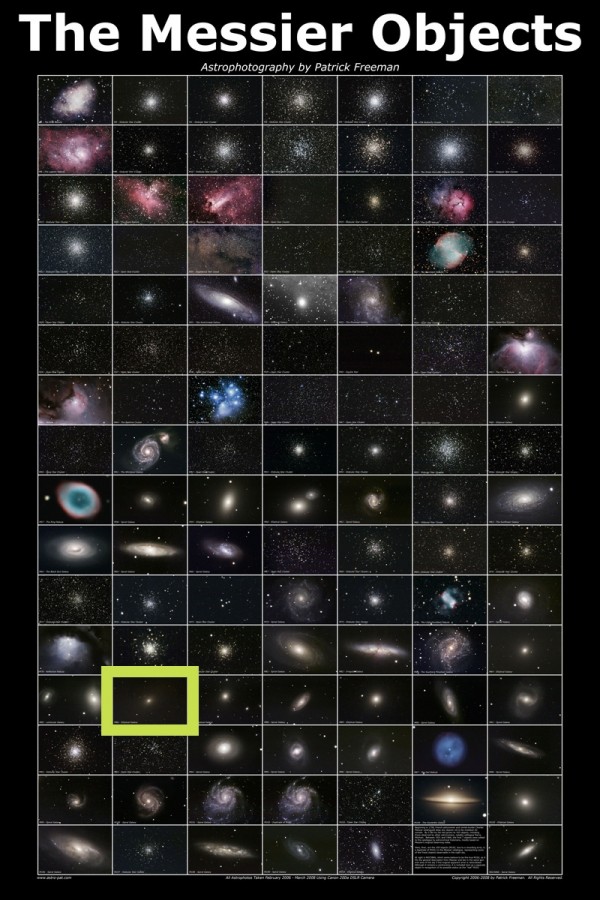 Image credit: © 2008 by Patrick Freeman of http://www.astro-pat.com/.
Image credit: © 2008 by Patrick Freeman of http://www.astro-pat.com/.
This week, we're going to travel deep into the Virgo Cluster -- the nearest giant cluster of galaxies to us -- to find one of the most extreme objects in the entire night sky. We've entered the Virgo Cluster once before here on Messier Monday, but we'll be going back often; there are a whopping fifteen galaxies in the Virgo Cluster represented in the Messier Catalogue! Today, we're taking a look at a unique, very large elliptical galaxy, Messier 86. Here's how to find it.
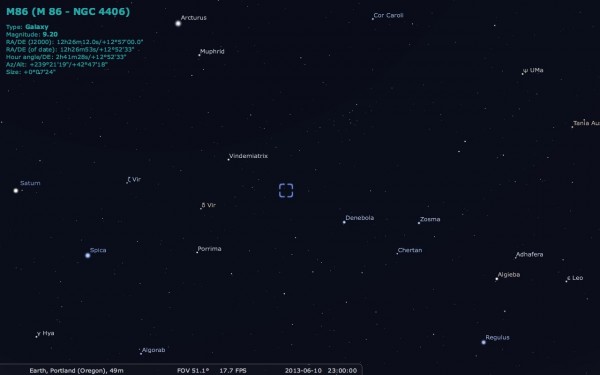 Image credit: me, using the free software Stellarium, via http://stellarium.org/.
Image credit: me, using the free software Stellarium, via http://stellarium.org/.
The brightest star in the northern celestial hemisphere is the orange giant Arcturus, which you can always easily find by following the "arc" of the Big Dipper's handle. A little farther along -- if you "speed-on" -- you can find the bright blue star, Spica, with the planet Saturn hanging out nearby towards the east these days. But if you look in the other direction, towards the west of the imaginary line connecting Arcturus-to-Spica, you'll see a few other prominent stars, including Vindematrix and Denebola. If you can locate those stars, you can find Messier 86.
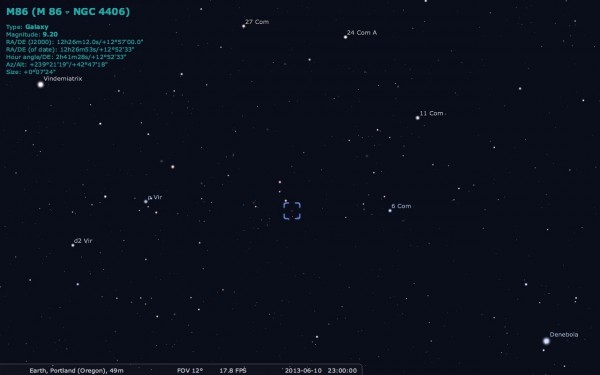 Image credit: me, using the free software Stellarium, via http://stellarium.org/.
Image credit: me, using the free software Stellarium, via http://stellarium.org/.
Practically directly between those two stars, there are virtually no other stars that stand out; the closest you'll get are the fifth-magnitude ones labelled above. But directly between those two stars -- practically equidistant from both -- you'll find a series of fuzzy, dim lights through a telescope or binoculars. Look for the following configuration of Hipparcos stars through your eyepiece(s), and you'll be well on your way to finding Messier 86.
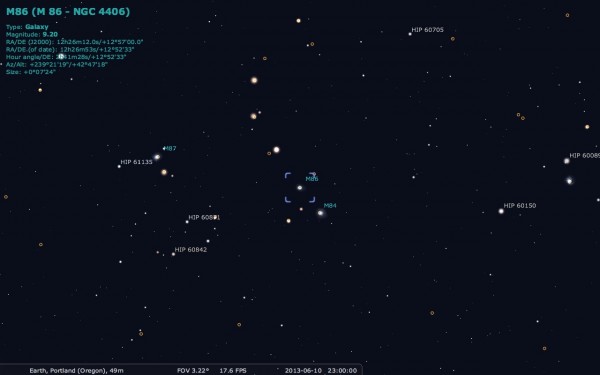 Image credit: me, using the free software Stellarium, via http://stellarium.org/.
Image credit: me, using the free software Stellarium, via http://stellarium.org/.
Let's remind ourselves what the Virgo Cluster is, to get a sense of what we're looking into when we're seeing this object. A collection of more than 1,000 large galaxies, the Virgo Cluster literally dwarfs all the other, smaller clusters and groups within 50 million light-years of our Milky Way.
Deep in the heart of the Virgo Cluster -- which is where we're looking -- there are a series of big, intrinsically bright, very massive galaxies. Some of the brightest -- and their relative positions -- are shown below.
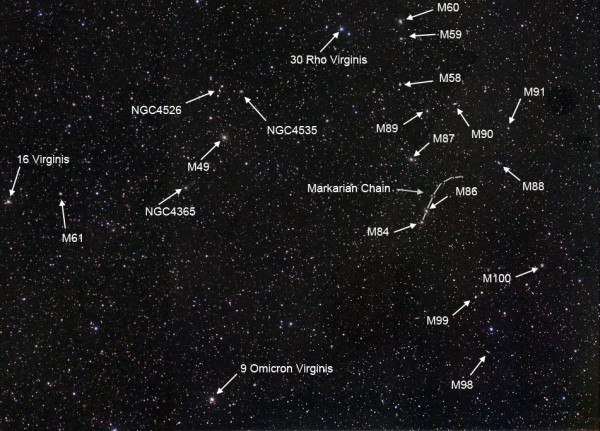 Image credit: George and Pat of http://www.geoandpat.com/GeorgesastrogalaxiesMarkarian.html.
Image credit: George and Pat of http://www.geoandpat.com/GeorgesastrogalaxiesMarkarian.html.
This galaxy, M86, is actually part of a very famous chain of galaxies, Markarian's Chain, found there. Messier 86 is the giant elliptical that's second-from-the-end, as pointed out with the orange arrow below.
Giant elliptical galaxies are rarities in our local corner of the Universe; we are dominated by spirals, both large and small. What's so different about the Virgo Cluster? When you get this much mass together in such a (relatively) small region of space, gravitational interactions and mergers between galaxies is much more common.
And when approximately equal-sized objects merge together, or when many mergers take place over billions of years, the result is inevitably larger, more elliptically-shaped galaxies.
 Image credit: Mark Whittle of http://www.astro.virginia.edu/.
Image credit: Mark Whittle of http://www.astro.virginia.edu/.
We find that in relatively sparse regions -- like our local group -- practically all of the galaxies are spirals, while in large clusters and superclusters -- like Virgo -- a great percentage are ellipticals. The percentage of ellipticals will only rise as time goes on.
So what's so special about Messier 86?
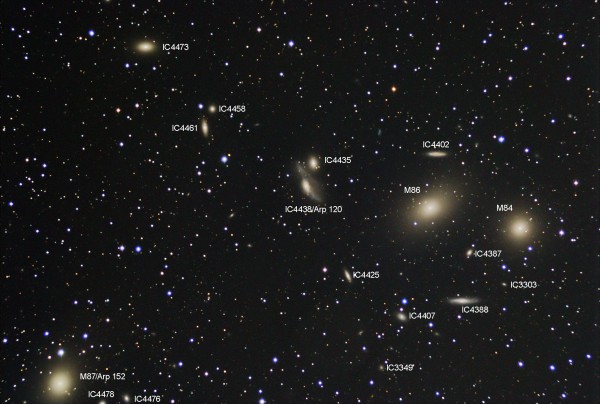 Image credit: Mauro Da Lio of http://visualreports.blogspot.com/.
Image credit: Mauro Da Lio of http://visualreports.blogspot.com/.
At around 53 million light-years distant, it lies in the heart of the Virgo cluster, just slightly off-center from the cluster's calculated center-of-mass. With more than three thousand globular clusters in its halo -- maybe 20 times the number our Milky Way has -- it's full of a huge number of stars that are much older than the typical stars found within our galaxy.
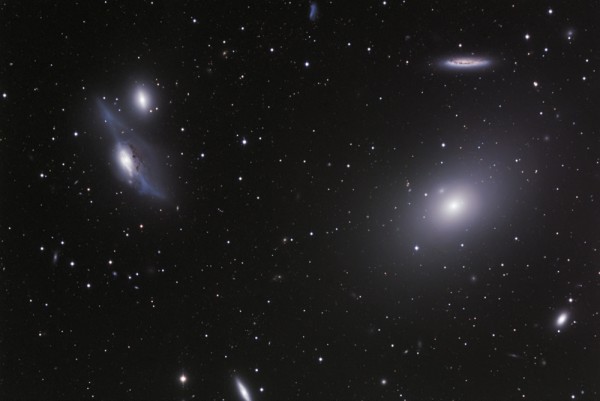 Image credit: Scott Hammonds of http://www.creatorsview.com/.
Image credit: Scott Hammonds of http://www.creatorsview.com/.
As a giant elliptical, it looks rather non-descript; far less interesting, visually, than its neighboring, merging pair of galaxies known best as The Eyes. It appears to be having dust stripped away from it, and may be merging with the smaller galaxy seen directly atop it in the image above.
But there's something fantastic that separates Messier 86 from all of its nearby neighbors.
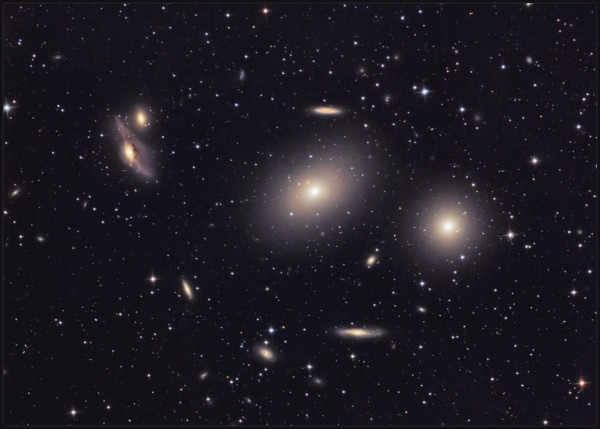 Image credit: Anonymous image submitter, via http://www.pbase.com/image/133948017.
Image credit: Anonymous image submitter, via http://www.pbase.com/image/133948017.
You see, being some 50 million light-years away in an expanding Universe, the entire Virgo Cluster recedes from us at an average of about 1,000 km/sec, or some significant fraction (0.3%) the speed of light! But while all the other galaxies in the image above recede from us at somewhere around that speed, Messier 86 approaches us at some speed between 244 and 419 km/sec, depending on who's measuring it!
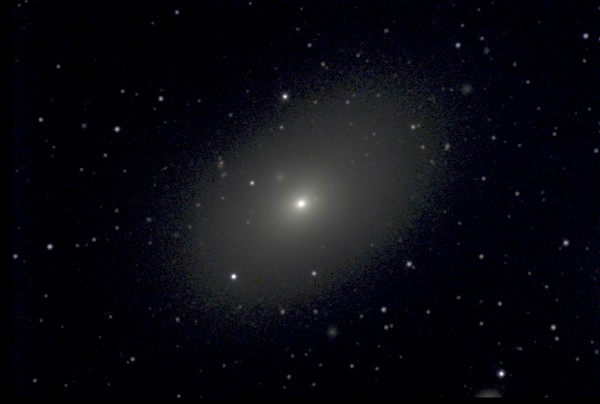 Image credit: Josh Stoep of Calvin College, via http://www.calvin.edu/.
Image credit: Josh Stoep of Calvin College, via http://www.calvin.edu/.
How is this possible? Remember that every galaxy in the Universe, while they're all caught up in the Hubble expansion of the Universe, they also are subjected to the local gravitational field of wherever they're located. In the case of Messier 86, it's on the opposite side of the Virgo Cluster from us, and is speeding towards the center of it so quickly -- possibly as great as 1,500 km/sec -- that it's actually blueshifted relative to our point of view!
You might be skeptical of this claim, but you wouldn't be if you looked at the Chandra X-ray image, which clearly shows a "tail" to this galaxy as it plows through the intra-cluster medium at breakneck speed!
 Image credit: NASA / CXC / SAO / C. Jones / W. Forman / F. Murray, with visible in orange (via DSS / Palomar) and X-ray in blue.
Image credit: NASA / CXC / SAO / C. Jones / W. Forman / F. Murray, with visible in orange (via DSS / Palomar) and X-ray in blue.
This is actually fairly typical of galaxies in the Virgo Cluster, to have what we call peculiar velocities of as much as a few thousand km/sec. Messier 86 isn't even the fastest blueshift in the Virgo Cluster; that distinction belongs (currently) to IC 3258, which approaches us at more than 500 km/sec. But it is the most blueshifted of not only all Messier galaxies, but of all Messier objects, period!
Pretty remarkable, especially for such an un-remarkable-looking elliptical galaxy.
So don't just look up at this object as a "common," boring elliptical dead-and-red galaxy; this is one of the most vibrant, speeding galaxies -- relative to its home cluster's center-of-mass, especially -- that you can find in the entire sky! Explore the Virgo Cluster if you get a chance; it's high in the night sky for the early part of the night now and for the next few months; don't miss it!
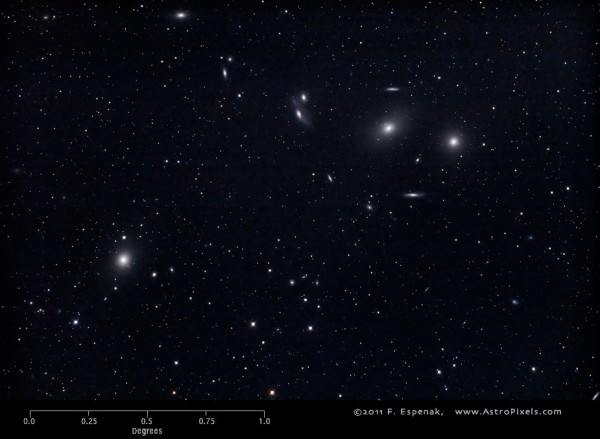 Image credit: Fred Espenak of http://astropixels.com/.
Image credit: Fred Espenak of http://astropixels.com/.
And that’s all for another Messier Monday! Including today’s entry, we’ve taken a look at the following Messier objects:
- M1, The Crab Nebula: October 22, 2012
- M5, A Hyper-Smooth Globular Cluster: May 20, 2013
- M8, The Lagoon Nebula: November 5, 2012
- M13, The Great Globular Cluster in Hercules: December 31, 2012
- M15, An Ancient Globular Cluster: November 12, 2012
- M20, The Youngest Star-Forming Region, The Trifid Nebula: May 6, 2013
- M25, A Dusty Open Cluster for Everyone: April 8, 2013
- M29, A Young Open Cluster in the Summer Triangle: June 3, 2013
- M30, A Straggling Globular Cluster: November 26, 2012
- M33, The Triangulum Galaxy: February 25, 2013
- M37, A Rich Open Star Cluster: December 3, 2012
- M38, A Real-Life Pi-in-the-Sky Cluster: April 29, 2013
- M40, Messier’s Greatest Mistake: April 1, 2013
- M41, The Dog Star’s Secret Neighbor: January 7, 2013
- M44, The Beehive Cluster / Praesepe: December 24, 2012
- M45, The Pleiades: October 29, 2012
- M48, A Lost-and-Found Star Cluster: February 11, 2013
- M51, The Whirlpool Galaxy: April 15th, 2013
- M52, A Star Cluster on the Bubble: March 4, 2013
- M53, The Most Northern Galactic Globular: February 18, 2013
- M60, The Gateway Galaxy to Virgo: February 4, 2013
- M65, The First Messier Supernova of 2013: March 25, 2013
- M67, Messier’s Oldest Open Cluster: January 14, 2013
- M72, A Diffuse, Distant Globular at the End-of-the-Marathon: March 18, 2013
- M74, The Phantom Galaxy at the Beginning-of-the-Marathon: March 11, 2013
- M78, A Reflection Nebula: December 10, 2012
- M81, Bode’s Galaxy: November 19, 2012
- M82, The Cigar Galaxy: May 13, 2013
- M83, The Southern Pinwheel Galaxy, January 21, 2013
- M86, The Most Blueshifted Messier Object, June 10, 2013
- M92, The Second Greatest Globular in Hercules, April 22, 2013
- M97, The Owl Nebula, January 28, 2013
- M102, A Great Galactic Controversy: December 17, 2012
- M104, The Sombrero Galaxy: May 27, 2013
Come back next week, where we'll look at another one of the deep-sky objects that make up the Messier Catalogue, only here, only on Messier Monday!
- Log in to post comments

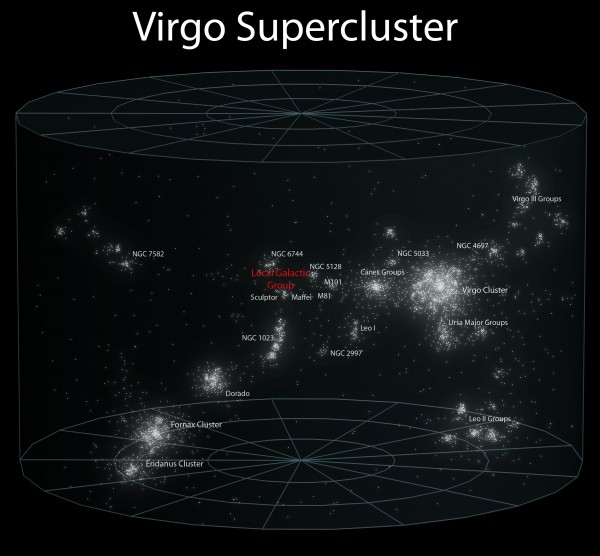
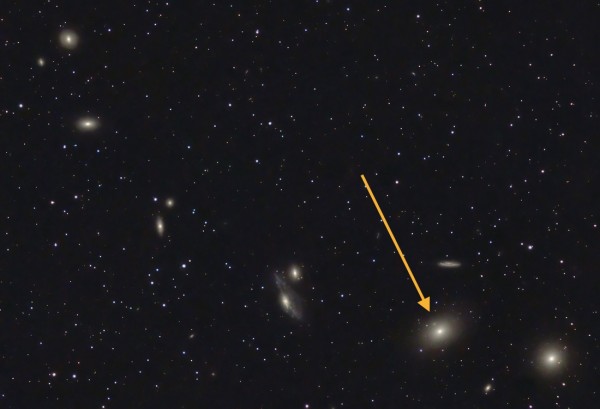
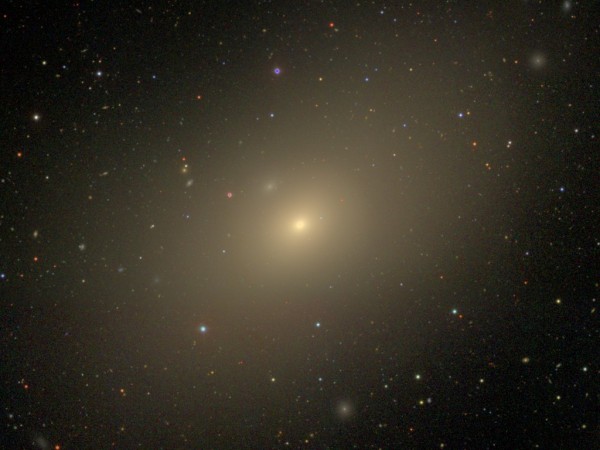
OK, so if I understand you correctly, the reason that M86 is blueshifted is that its direction of motion is toward the gravitational center of the Virgo cluster, and coincidentally that happens to be in our direction. Is that approximately right?
In that case would we expect that in astronomical time it will eventually swing around the gravitational center of the Virgo cluster and perhaps enter an elliptical orbit or a spiraling trajectory toward the center? And would we also reasonably expect it to drag some other lower-mass galaxies along in its wake?
I'm going to stick my neck out and say it appears to me that blueshifted galaxies could be useful as points of reference for measurements of the motion of other galaxies in their vicinity, by comparing the spectra of light emitted by the objects in question.
Awe & Reverence Dep't: That fuzzy blue thing, and all the other fuzzy things around it, are each composed of millions of stars.
Clueless Layperson Question Dep't: If you were standing on a planet orbiting a star in a galaxy close to the center of that cluster, how would the ambient starlight compare in brightness to the light of our Sun and Moon?
G: Yep, it is orbiting the cluster, and I wouldn't be surprised if it had its own satellite galaxies orbiting it.
Comparing the spectra to that expected if there was no motion relative to us is how we came to call it 'blue shifted' in the first place. We figure out the velocities of other objects in the same way. Comparing to other objects in the vicinity would only help matters if you thought that the spectra would be related, but that's dependent on the type of object, not location in space.
I've been catching up on some previous blogs from the last month. Given the nature of some of the comments (specifically posts on 5/10, 5/23, 5/29, 5/31), I would just like to throw in my $0.02.
I have been reading this blog for several years. I'm in my late twenties, hold physics, engineering and music degrees, and work as an electrical engineer in a university environmental research department.
Ethan's StartsWithABang is very interesting and informative to me, but also energizes me to educate others on the great accomplishments of science and its undeniable implications--both good and bad--on the past and future of humanity. It is obvious that this idea of public education is a central tenet of Ethan's in writing this blog, and I genuinely take it to heart.
However, despite the overwhelmingly benign nature of the blog and its author, there are regular commenters who insist on attacking others via derogatory, demoralizing, and sometimes down-right hateful rhetoric. This negativity shames the intended spirit of the blog and is overwhelmingly rude towards Ethan. I'm sure it is very disheartening for him to be forced multiple times into calls for civility, especially when his goals directly depend on it. And I'm sure we can do better.
I hope that everybody recognizes what a noble and difficult mission Ethan is trying to accomplish. The negative comments on his own blog is directly counterproductive to this mission. At the least, we can support and respect him by using rhetoric in the form of logic, not of loathing.
Carl Sagan said it best in the following quote about dissonant ideas: "...let us temper our criticism with kindness. None of us comes fully equipped."
Tone troll is boring.
CB: Thanks. So if there are small galaxies already orbiting M86, we could detect that by analyzing their light spectra to look for ones that appear to be in relative motion to M86. Understood that we need to know what types of objects we're looking at, for example as with stars at various stages in their life cycle (red is red, and if red-shifted, even-redder;-) But it also seems to me that all the stars in a galaxy ought to average to a mean value, and the mean values should be useful here.
Meanwhile, on a planet like ours, orbiting a star like ours, somewhere in that cluster, someone else is probably having a similar conversation about the Milky Way;-)